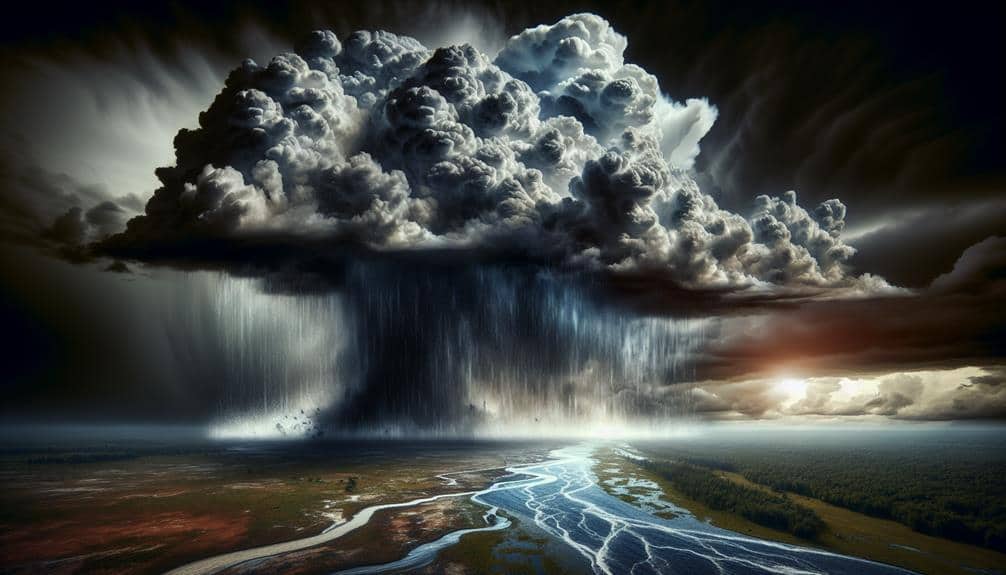Understanding climate change's impact on storm characteristics shows that we're facing more intense and frequent storm systems. Rising sea surface temperatures intensify these storms, leading to higher wind speeds and an uptick in severe hurricanes. Shifting storm tracks and enhanced rainfall rates contribute to increased coastal erosion and regional shifts in precipitation patterns. Prolonged storm durations and heightened storm surges present severe challenges for coastal communities and infrastructures. These data-driven insights underscore the necessity for adaptive strategies to mitigate these evolving threats. Let's explore the detailed implications and the scientific basis behind these dramatic changes.
Key Points
- Rising sea surface temperatures are intensifying storm systems, leading to stronger and more frequent hurricanes.
- Climate change is shifting storm tracks, causing altered weather patterns and affecting previously less-affected regions.
- Increased storm frequency and intensity are causing significant coastal erosion and economic damage.
- Enhanced rainfall rates from intensified storms heighten flood risks and challenge water management systems.
Rising Sea Surface Temperatures
Rising sea surface temperatures are a key driver in the intensification of storm systems, as evidenced by increasing frequency and severity of recent storms. When we examine the data, it's clear that warmer oceans aren't just a catalyst for more powerful storms, but they also contribute to ocean acidification and coral bleaching.
This warming disrupts marine ecosystems, leading to a cascade of environmental consequences. Studies show that as sea surface temperatures rise, the ocean absorbs more carbon dioxide. This process increases the acidity of the water, which can have detrimental effects on marine life.
Coral reefs, in particular, suffer from this phenomenon. Coral bleaching occurs when the symbiotic algae living in coral tissues are expelled due to stress caused by higher temperatures and increased acidity. These algae provide corals with essential nutrients and their vibrant color; without them, corals turn white and are more susceptible to disease and death.
As we analyze these interconnected issues, it's evident that our quest for freedom must include the preservation of our oceanic environments. By understanding the specific impacts of rising sea surface temperatures, we can advocate for informed, science-based policies to mitigate these effects.
Increased Storm Intensity
As we examine increased storm intensity, we should focus on the correlation between rising ocean temperatures and enhanced wind speeds.
Data indicates that warmer sea surfaces fuel more powerful storms by providing additional energy. This relationship leads to storms with greater wind speeds and more destructive potential.
Rising Ocean Temperatures
Ocean temperatures have risen noticeably, leading to more intense and frequent storms. As we examine the data, we see that warmer oceans provide more energy to developing storms, intensifying their power. This increase in sea surface temperatures has already had profound effects on our marine ecosystems.
Coral bleaching, a direct consequence of this warming, disrupts the delicate balance of these underwater environments. Additionally, ocean acidification, driven by higher CO₂ levels, further stresses marine life, making it harder for species to survive and thrive.
When we look at the historical data, there's a clear upward trend in both the frequency and intensity of storms. For example, the National Oceanic and Atmospheric Administration (NOAA) reports a significant uptick in Category 4 and 5 hurricanes over the past few decades. This isn't just an academic concern; it has real-world implications for coastal communities and global biodiversity.
Enhanced Wind Speeds
Enhanced wind speeds, driven by rising sea surface temperatures, have led to a notable increase in storm intensity, evidenced by data from meteorological studies. As we investigate this phenomenon, we find that various environmental factors and wind patterns play pivotal roles.
- Rising Sea Surface Temperatures: Warmer oceans provide more energy, which heightens wind speeds.
- Shifting Wind Patterns: Changes in global wind patterns due to climate change result in more potent and unpredictable storms.
- Atmospheric Dynamics: Enhanced wind speeds are closely tied to shifts in atmospheric dynamics, impacting storm formation and intensity.
- Climate Modeling: Advanced climate models predict a continued trend of stronger storms as global temperatures rise.
By examining these points, we see a clear association between climate change and the observed increase in storm intensity. These changes in atmospheric dynamics and wind patterns illustrate how our planet's changing climate directly affects the frequency and strength of storms.
We must continue to refine our climate modeling to better predict future storm characteristics. Understanding these enhanced wind speeds helps us prepare for and mitigate the effects of increasingly intense storms, maintaining our ability to live safely and securely.
Changes in Storm Frequency

As we examine climate change's impact on storm frequency, we notice a significant increase in the number of storm incidents.
Our data also highlights shifts in seasonal patterns, indicating storms are occurring during times of the year previously considered atypical.
These trends suggest fundamental changes in atmospheric dynamics.
Increasing Storm Incidents
Recent data indicates that the frequency of severe storms has significantly increased over the past few decades, driven by climate change. This rise in storm incidents presents significant challenges for us, especially concerning coastal erosion and emergency preparedness. Our communities face heightened risks, and the evidence supporting these changes is strong and compelling.
- Increased coastal erosion: More frequent storms accelerate the wearing away of coastlines, threatening habitats and property.
- Emergency preparedness: With more storms, the need for effective emergency plans becomes essential to minimize loss of life and property.
- Infrastructure damage: Frequent storms lead to repeated damage to buildings, roads, and utilities, which strains repair efforts and financial resources.
- Community resilience: Communities must strengthen their resilience to bounce back from frequent storm events, requiring better planning and resources.
We must remain vigilant and proactive. By incorporating scientific data and analytical approaches, we can better understand storm frequency trends and develop strategies to mitigate their impacts. Our freedom lies in our ability to adapt and prepare for these increasing storm incidents, ensuring safer and more resilient communities.
Altered Seasonal Patterns
Climate change is altering seasonal storm patterns, leading to shifts in storm frequency that demand our attention and analysis. We've observed that these shifting weather patterns result in more extreme weather events, with storms occurring outside their traditional seasons. This variability disrupts established norms, challenging our ability to predict and prepare for these occurrences.
Data indicates that changing precipitation patterns are a key factor in this phenomenon. As global temperatures rise, the atmosphere holds more moisture, leading to more intense and frequent storms. We see this in both tropical and temperate regions, where storms aren't only more powerful but also more erratic in their timing.
Weather variability is becoming the new norm, with some regions experiencing prolonged dry spells followed by sudden, heavy rainfall. This unpredictability complicates our efforts to manage water resources and prepare for natural disasters. The freedom to plan our activities and safeguard our communities hinges on understanding these changes.
In analyzing storm frequency, we must consider the broader implications of these altered seasonal patterns. By adapting our strategies and infrastructure, we can better navigate the challenges posed by a changing climate and protect our way of life.
Altered Storm Tracks
Meteorological data reveals that shifting storm tracks are a significant consequence of global climate change, altering weather patterns and impacting ecosystems worldwide. As our climate warms, we see clear evidence of changing atmospheric circulation, which in turn modifies storm pathways. These shifts lead to altered storm behavior and shifting precipitation patterns that can profoundly affect both natural and human systems.
We face several critical changes:
- Increased storm frequency: Storms are occurring more often in regions that traditionally had fewer such events.
- Poleward migration: Storm tracks are moving towards the poles, affecting regions that were once less storm-prone.
- Altered intensity: The strength of storms is changing, with some regions experiencing more severe weather events.
- Regional precipitation changes: Areas are experiencing either more intense rainfall or prolonged droughts, depending on the shifting storm tracks.
We need to focus on understanding these changes to better prepare and adapt. By analyzing data and developing strategies, we can mitigate the effects of these shifting storm tracks and support the resilience of our ecosystems and communities.
Enhanced Rainfall Rates

Amid rising global temperatures, we've observed a significant increase in rainfall rates during storms, leading to heightened flood risks and water management challenges. This trend is closely tied to the intensification of the hydrological cycle and increased atmospheric moisture. Warmer air holds more water vapor, which in turn fuels extreme precipitation events. Data from the Intergovernmental Panel on Climate Change (IPCC) indicates a clear upward trend in the frequency and intensity of such events.
Climate variability further complicates our understanding and prediction capabilities. Variations in regional climate patterns, such as El Niño and La Niña, influence the distribution and severity of rainfall. These phenomena, combined with long-term global warming, create a complex interplay that exacerbates precipitation extremes.
We've also noted that the increased rainfall rates aren't uniformly distributed. Certain regions experience severe flooding, while others may see reduced precipitation. The uneven distribution poses significant challenges for water resource management and infrastructure planning. Urban areas, in particular, are vulnerable due to impermeable surfaces that hinder natural water absorption, amplifying flood risks.
Addressing these challenges requires adaptive strategies that consider both the short-term climate variability and long-term trends in atmospheric moisture and hydrological cycles. Only by doing so can we mitigate the adverse impacts of enhanced rainfall rates effectively.
Prolonged Storm Durations
Increasingly, we've observed that storms are lasting longer, exacerbating the damage caused by prolonged exposure to severe weather conditions. This trend isn't just a matter of perception but is supported by extensive data analyses. Longer storm durations lead to more sustained impacts on local infrastructure and challenge our emergency response systems in unprecedented ways.
Key factors contributing to prolonged storm durations include:
- Warmer sea surface temperatures: These provide more energy for storm systems, allowing them to maintain strength over longer periods.
- Changes in atmospheric circulation: Altered jet streams and pressure systems can cause storms to stall or move more slowly.
- Increased moisture in the atmosphere: More available water vapor can sustain storm systems, extending their duration.
- Urban heat islands: Cities can enhance storm longevity by providing additional heat and moisture.
Prolonged storms put a significant strain on local infrastructure, from prolonged flooding to more extensive wind damage. Emergency response teams are also stretched thin, needing to provide continuous support and resources over longer periods.
Addressing these challenges requires adaptive strategies and thorough planning to mitigate the detrimental effects on our communities.
Impacts on Storm Surge

Storm surge, driven by rising sea levels and intensified storm systems, poses a growing threat to coastal communities worldwide. As sea levels continue to rise, the baseline from which storm surges start is elevated, leading to higher and more destructive surges. This exacerbates coastal vulnerability, putting homes, businesses, and critical infrastructure at heightened risk. Data reveals that each centimeter of sea level rise can lead to significant increases in storm surge height, amplifying the potential for widespread flooding.
We must also consider the compounded impact on infrastructure damage and emergency response efforts. When storm surges inundate coastal areas, they can cripple transportation networks, electrical grids, and water supply systems. This not only disrupts daily life but also hinders effective emergency response, delaying rescue operations and recovery efforts. In regions prone to frequent storm surges, investing in robust storm defense measures, such as seawalls and flood barriers, becomes essential.
Analyzing historical storm data shows a troubling trend: storm surges are becoming more frequent and severe. Our collective response should focus on enhancing coastal defenses, improving infrastructure resilience, and refining emergency response strategies to mitigate the impacts of these increasingly powerful natural phenomena.
Frequently Asked Questions
How Do Climate Models Predict Future Storm Behaviors?
We use climate models to analyze climate data, providing projections on future storm behaviors. These models predict changes in storm frequency and intensity, enabling us to prepare for potential impacts and make informed decisions for our communities.
What Are the Economic Impacts of Changing Storm Characteristics?
We're analyzing the economic repercussions of changing storm patterns. Increased storm severity has significant financial implications, including higher insurance costs, infrastructure damage, and recovery expenses. These changes demand adaptive strategies to mitigate economic vulnerabilities and guarantee resilience.
How Can Communities Better Prepare for Evolving Storm Patterns?
To boost community resilience, we must adapt our infrastructure like a fortress against evolving storm patterns. Enhancing disaster preparedness and emergency response guarantees we're ready for anything. Data-driven strategies empower us to protect our freedom and livelihoods.
What Role Do Human Activities Play in Altering Storm Characteristics?
We contribute to altering storm characteristics by emitting greenhouse gases, which increase extreme weather frequency. Scientific attribution studies link our emissions to more intense storms, emphasizing the need for emission reductions to preserve our freedom from severe weather impacts.
How Does Climate Change Affect the Insurance Industry Regarding Storm Damage?
Climate change causes catastrophic consequences, compelling us to reconsider risk assessment and coverage adjustments. Insurance premiums surge, and we must adopt adaptation strategies to stay resilient. Data-driven decisions guarantee our freedom to thrive despite increasing storm damage.


